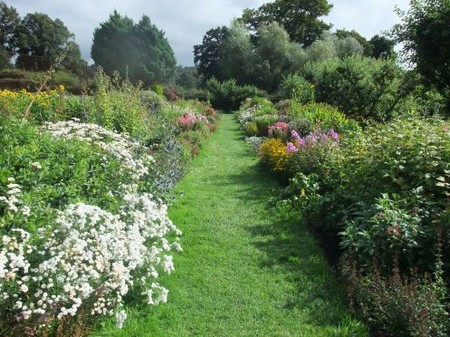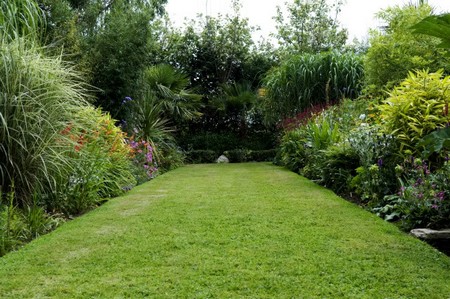Best Way to Lay Out a Border in Small Garden
In a smaller garden, you can lay out garden hose to mark where you want flower beds, lawns, and paths. It’s difficult to see the hose on the ground when you’re on the same level, so take a look from various windows in the house. Another technique I’ve used to help me visualize a border of growing plants involved adding another dimension. My solution was to put five-foot stakes, three feet apart, around the space proposed for the border, and to loop orange surveyor’s ribbon over the top of the stakes.
If your garden is set in a wide-open natural landscape, then that landscape itself is already part of your garden; your eyes will make it so. You could block it out, I suppose, but why not use something beautiful when it’s given to you? (Perhaps “lent” is the better word, since this is referred to in textbooks as “borrowed landscape.”)
If you decide to have hedges or clusters of trees to give some sense of enclosure to your garden, you may find part of the distant view even more pleasing when glimpsed through the frame of a carefully placed break in the hedge. Something partially seen is often more exciting; it concentrates the eye and invites investigation.
Even if your garden is small, with constraints of fences and houses on either side, the same principle of “borrowing” could apply. You might be in luck.
Without room for (or time to wait for) a mature, spreading, flowering crab apple, enjoy a few branches that hang over the neighbor’s fence, and let the whole lovely canopy provide you with a background each spring. If the other neighbor should happen to have a handsome hemlock, holly, or other evergreen, you’ve really got it made; make whatever you plant play off against that dark green form.
If there’s anything at all in your garden that would make a background for a flower border, take advantage of it. Before you say there is nothing, run through this list of possibilities: an existing hedge or fence; the house itself; a neighboring house; other buildings, such as a garage, toolshed, outhouse (this is a serious suggestion—a most elegant estate in Pennsylvania has an old one—gussied up, admittedly, but still scarcely a temple or gazebo); a retaining wall of stone or timbers; bordering woods; a pond or pool (water is beautiful but a little difficult to use successfully as a background); a clump of broad-leaved evergreens or ornamental grasses.
If nothing presents itself, as it did not in that two-acre expanse I mentioned earlier, let me tell you how I provided background for the big horseshoe perennial border. Rather than take on the work and expense of putting in a uniform hedge and also, let me say, preferring variety, I turned to small trees and deciduous shrubs. I planted occasional small trees behind the eight-foot border, allowing space for a riding mower to maneuver between trees and border. Carolina silverbell, sourwood, and shadblow, all hardy to Zone 5, have taken well there. I planted single specimens and now realize I must add to them so that there will be a small group of each kind extending back into the meadow. At either end of the bed, I planted weeping hemlock, which effectively terminates and holds down the horseshoe. These are growing well, but very slowly.
Along the rear of the border, I planted groups of shrubs, most of them deciduous, because I like the double bonus of spring flowers and autumn color. Enkianthus campanulatus is a favorite of mine. It doesn’t seem to have a common name—perhaps if it did it would be grown more often. Small yellow and red bells open in clusters in May, before the leaves appear; the brilliant red autumn foliage is memorable. I am content to grow oak-leaf hydrangea for its huge leaves, the color of cordovan leather in fall, but north of Zone 6 it will rarely give the panicles of pure white bloom pictured in catalogs. Weigela contributes flowers in a wide range of color from white to burgundy, while mock orange and many of the viburnum family offer white flowers of great fragrance.
Categories
Advertisements
Recent Articles
 How to Understand Bed Sizes – A Small Guide
How to Understand Bed Sizes – A Small Guide How to Select Some Must Have Kitchen Accessories
How to Select Some Must Have Kitchen Accessories Best Way to Change a Car Tire
Best Way to Change a Car Tire Best Way to Write an Affirmation
Best Way to Write an Affirmation Best Way to Take Charge of Your Financial Life
Best Way to Take Charge of Your Financial Life Best Way to Survive a Party When You Don’t Know Anyone
Best Way to Survive a Party When You Don’t Know Anyone Best Way to Stop Self Sabotaging Yourself
Best Way to Stop Self Sabotaging Yourself Best Way to Start Journal Writing
Best Way to Start Journal Writing Best Way to Speak with a Powerful Voice
Best Way to Speak with a Powerful Voice Best Way to Simplify Your Life
Best Way to Simplify Your Life Best Way to Respond to a Put-Down
Best Way to Respond to a Put-Down Best Way to Reduce Acne Breakouts
Best Way to Reduce Acne Breakouts Best Way to Recover from Dining Disasters
Best Way to Recover from Dining Disasters Best Way to Quit Your Job Gracefully
Best Way to Quit Your Job Gracefully Best Way to Make Your Own Website
Best Way to Make Your Own Website



Leave a Reply